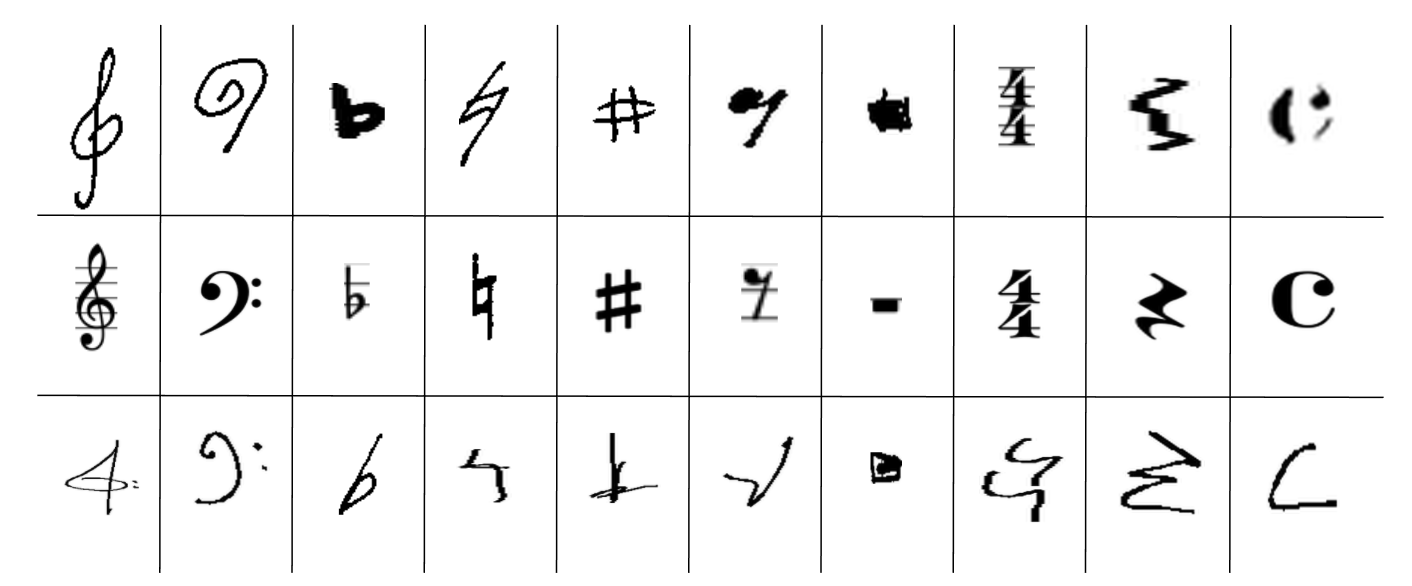This repository is the model trainer part of the Universal Music Symbol Classifier, which classifies handwritten Music Symbols into 79 different classes using Deep Learning and a massive dataset of over 90000 tiny images. It is part of a set of two tools:
| Model Trainer | Manual Classifier |
|---|---|
| Trains a deep network to automatically classify images of handwritten music symbols into 32 different classes. | Mobile Android application that uses a trained model to perform real-time classification on a mobile device. |
Note my previous project which classifies images into Music scores or something else which can be found in this repository on Github and my current project that tries to perform Music Object Detection (Object Detection for Music Symbols).
An extensive overview of the results of different parameters is documented in this Google Spreadsheet and you may also take a look at this presentation, given at GREC 2017.
This scientific paper contains more information on this research, including condensed results. If you find this research useful, please consider citing it as:
@InProceedings{Pacha2017,
author = {Pacha, Alexander and Eidenberger, Horst},
title = {Towards a Universal Music Symbol Classifier},
booktitle = {14th International Conference on Document Analysis and Recognition},
year = {2017},
pages = {35--36},
address = {Kyoto, Japan},
organization = {IAPR TC10 (Technical Committee on Graphics Recognition)},
publisher = {IEEE Computer Society},
doi = {10.1109/ICDAR.2017.265},
isbn = {978-1-5386-3586-5},
issn = {2379-2140},
}
This repository contains several scripts that can be used independently of each other. Before running them, make sure that you have the necessary requirements installed.
- Python 3.5+ (tested with 3.9)
- Tensorflow 2.8.0
Optional: If you want to print the graph of the model being trained, install GraphViz on Windows via http://www.graphviz.org/Download_windows.php and add /bin to the PATH or run sudo apt-get install graphviz on Ubuntu (see keras-team/keras#3210)
For installing Tensorflow and Keras we recommend using Anaconda or Miniconda as Python distribution (we did so for preparing Travis-CI and it worked).
Run python ModelTrainer/TrainModel.py or ModelTrainer/TrainBestModel.ps1 for automatically training a neural network with the best available configuration. It will automatically download and extract the HOMUS dataset.
The result of this training is a .h5 (e.g. res_net_4.h5) file that contains the trained model and when running via the PowerShell-script a transcript of the entire training is also created for later investigation.
TrainModel.py has a couple of parameters that can be changed for the training. Note that all options have meaningful default values, so they are completely optional:
--dataset_directorythe folder where the images should be stored. Default isdata--datasetsSpecifies which datasets are used for the training. One or multiple datasets of the following are possible: homus, rebelo1, rebelo2, printed, audiveris, muscima_pp, fornes or openomr. Multiple values are connected by a separating comma, i.e.homus,rebelo1.--use_existing_dataset_directoryWhether to delete and recreate the dataset-directory (by downloading the appropriate files from the internet, extracting and generating images) or simply use whatever data currently is inside of that directory. This flag should not be provided, if you switch datasets.--model_namethe name of the model configuration used for training (e.g.vgg4). RunListAvailableConfigurations.ps1ormodels/ConfigurationFactory.pyto get a list of all available configurations--widthWidth of the input-images for the network in pixel--heightHeight of the input-images for the network in pixel
Further parameters for optional hyperparameter tuning
--minibatch_sizeSize of the minibatches for training, typically one of 8, 16, 32, 64 or 128--optimizerThe optimizer used for the training, can be SGD, Adam or Adadelta--no_dynamic_learning_rate_reductionTrue, if the learning rate should not be scheduled to be reduced on a plateau--class_weights_balancing_methodThe optional weight balancing method for handling unbalanced datasets. If provided, valid choices are simple or skBalance. 'simple' uses 1/sqrt(#samples_per_class) as weights for samples from each class to compensate for classes that are underrepresented. 'skBalance' uses the Python SkLearn module to calculate more sophisticated weights.
Published under MIT License,
Copyright (c) 2022 Alexander Pacha, TU Wien
Permission is hereby granted, free of charge, to any person obtaining a copy of this software and associated documentation files (the "Software"), to deal in the Software without restriction, including without limitation the rights to use, copy, modify, merge, publish, distribute, sublicense, and/or sell copies of the Software, and to permit persons to whom the Software is furnished to do so, subject to the following conditions:
The above copyright notice and this permission notice shall be included in all copies or substantial portions of the Software.
THE SOFTWARE IS PROVIDED "AS IS", WITHOUT WARRANTY OF ANY KIND, EXPRESS OR IMPLIED, INCLUDING BUT NOT LIMITED TO THE WARRANTIES OF MERCHANTABILITY, FITNESS FOR A PARTICULAR PURPOSE AND NONINFRINGEMENT. IN NO EVENT SHALL THE AUTHORS OR COPYRIGHT HOLDERS BE LIABLE FOR ANY CLAIM, DAMAGES OR OTHER LIABILITY, WHETHER IN AN ACTION OF CONTRACT, TORT OR OTHERWISE, ARISING FROM, OUT OF OR IN CONNECTION WITH THE SOFTWARE OR THE USE OR OTHER DEALINGS IN THE SOFTWARE.
